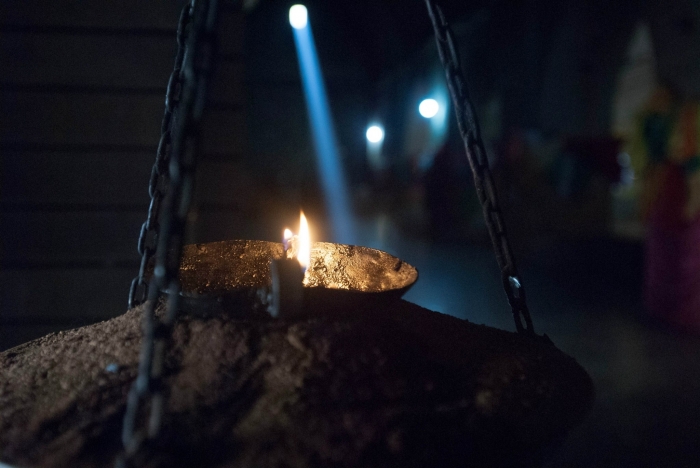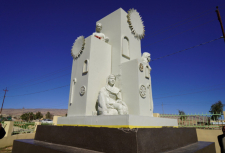Yezidism – its background observances and textual tradition. The 'Sacred Books'

The publication of the 1872 document, as a written source of undoubted authenticity, was an important event in the history of the study of Yezidism. It was to be overshadowed, however, by more spectacular discoveries. Siouffi, who brought about the second stage in the history of Yezidi Studies by identifying Sheykh Adi, also adumbrated the next. In an interview with him, the Baba Sheykh of the time confirmed the existence of two sacred texts, about which rumours had long existed. These were entitled Jilwe (i.e., "Splendour" or "Unveiling") and Meshefa Resh ("The Black Book", hereafter Meshef Resh). Both works were said to be in Arabic and the latter was described as a commentary upon the former. In the interview the texts were referred to as "books", and in fact written copies were to appear not long afterwards.
In 1874, it seems, Ishak of Bartella—a Christian priest who had spent much of his life in Ba'shiqe, the home of the Yezidi Qewwals—completed a long manuscript in Syriac about the history, traditions and observances of the Yezidis. It has been suggested that his information derived largely from a manual used for the training of Qewwals by a Yezidi called Mulla Haydar. This Mulla Haydar had also been Siouffi's source of information, and he may have been helpful to foreign researchers on other occasions. A manuscript of Ishak's work, which was composed in the form of question and answers, was long kept in the library of the monastery of Rabban Hormuzd at AJkosh. An Arabic version of the text was in the possession of Jeremiah Shamir, who had once been a monk in that monastery, in 18 84. Later in life Shamir was, among other things, a dealer in books and manuscripts. From the late 1880s onwards, he was instrumental in obtaining for Western collectors a number of manuscripts which included the texts of the Jilwe and the Meshef Resh. Perhaps significantly, these texts do not seem to have pride of place in the manuscripts, but simply form part of a collection of texts about Yezidism. Most of these collections include an Arabic text entitled Tarlkh al- Azdiyya fi 'l-Mawsil wa Atrafihd ("History of the Yezidis in Mosul and its Environs"), and a Syriac treatise, Extract from the History of the Yezidis fi The latter text appears to be an abridged version in naixative prose of Ishak's catechism, The 1872 Petition is included in some of these collections, as part of the Tdrikh al~ Azdiyyafi In the beginning of the twentieth century, there were at least half a dozen manuscripts of the Yezidi 'Sacred Books' in existence. The provenance of these collections was shrouded in mystery but, as Guest puts it, "the common thread running through these conflicting and sometimes implausible accounts suggests that the texts of the Sacred Books were obtained from the Yezidis by trickery and that Jeremiah Shamir was somehow involved."
A publication of 1891 contained verbatim translations of passages from both texts. The first full translation of the texts, by E.G. Browne, appeared in 1895.
In 1909 Isya Joseph published the Arabic texts of both works, with an English translation. Two years later, in 1911, Pfere Anastase Marie announced Ms discovery of what he believed to be the original Kurdish versions. These were written in an otherwise unknown alphabet which bore no obvious resemblance to any other Middle Eastern script, but strangely had separate characters representing Arabic consonants which do not normally occur in Kurdish. Pcre Anastase showed his find to the Orientalist M. Bittner of Vienna, who published the texts in 1913, with a German translation. Bittner, who had at his disposal Oscar Mann's work on the Mukri dialect of Kurdish but was evidently unfamiliar with other forms of Central Kurdish, declared the language of the manuscripts to be an archaic form of Kurdish, and clearly regarded Anastase's texts as authentic.
Before the world of scholarship had time to build on these spectacular discoveries, however, an article appeared which challenged many of the assumptions made about the texts. In this publication, Alphonse Mingana rejected the notion that either the Arabic versions of the 'Sacred Books', Ishak of Bartella's work, or the Extracts represented an ancient scriptural tradition. He suggested that the author of all these texts was Jeremiah Shamir. Mingana pointed out that there is no evidence that copies of the texts existed before Shamir's time. He further argued that, since only one Yezidi family was permitted to learn to read and write, one would have expected the Sacred Books to be in its care. If these books had a traditional role in the religious life of the community, moreover, it might be expected that they would be publicly read on some occasions, such as the annual assemblies of the sect. Also, since Yezidi s, Muslims and Christians had lived closely together for fourteen hundred years, Mingana felt that members of the other communities would at least have heard rumours if such books had existed. None of this is in fact the case. Mingana then pointed to some statements in the texts which make it seem unlikely that they were written before the early nineteenth century, and to philological points which in his view suggested that the Arabic versions of the texts were written by a man who thought in Syriac, Jeremiah Shamir's first language. As far as Pere Anastase's discovery was concerned, Mingana called in question the plausibility of various points in the priest's account of this discovery. He went on to point out that neither he himself nor the Reverend A.N. Andrus, a long-time friend of the Yezidi community, had been able to find any confirmation of the existence of such books, and that the Prince of the Yezidis had in fact disclaimed any knowledge of it. Nor could Mingana find any plausible reason why a Yezidi should have translated his Sacred Books from Kurdish into Arabic, why such books should be kept in the Jebel Sinjar area rather than at a recognised centre of religious learning such as Ba'shiqe or Behzane, or why the different versions of the texts should show variants of the kind found here. The existence of a hitherto unknown script, unrelated to any of the alphabets used in the area, seemed to him unlikely.
Tags: #yazidisinfo #yezidi #aboutyazidi #sacredbooksyezidi
Yezidism – its background observances and textual tradition. The 'Sacred Books'

The publication of the 1872 document, as a written source of undoubted authenticity, was an important event in the history of the study of Yezidism. It was to be overshadowed, however, by more spectacular discoveries. Siouffi, who brought about the second stage in the history of Yezidi Studies by identifying Sheykh Adi, also adumbrated the next. In an interview with him, the Baba Sheykh of the time confirmed the existence of two sacred texts, about which rumours had long existed. These were entitled Jilwe (i.e., "Splendour" or "Unveiling") and Meshefa Resh ("The Black Book", hereafter Meshef Resh). Both works were said to be in Arabic and the latter was described as a commentary upon the former. In the interview the texts were referred to as "books", and in fact written copies were to appear not long afterwards.
In 1874, it seems, Ishak of Bartella—a Christian priest who had spent much of his life in Ba'shiqe, the home of the Yezidi Qewwals—completed a long manuscript in Syriac about the history, traditions and observances of the Yezidis. It has been suggested that his information derived largely from a manual used for the training of Qewwals by a Yezidi called Mulla Haydar. This Mulla Haydar had also been Siouffi's source of information, and he may have been helpful to foreign researchers on other occasions. A manuscript of Ishak's work, which was composed in the form of question and answers, was long kept in the library of the monastery of Rabban Hormuzd at AJkosh. An Arabic version of the text was in the possession of Jeremiah Shamir, who had once been a monk in that monastery, in 18 84. Later in life Shamir was, among other things, a dealer in books and manuscripts. From the late 1880s onwards, he was instrumental in obtaining for Western collectors a number of manuscripts which included the texts of the Jilwe and the Meshef Resh. Perhaps significantly, these texts do not seem to have pride of place in the manuscripts, but simply form part of a collection of texts about Yezidism. Most of these collections include an Arabic text entitled Tarlkh al- Azdiyya fi 'l-Mawsil wa Atrafihd ("History of the Yezidis in Mosul and its Environs"), and a Syriac treatise, Extract from the History of the Yezidis fi The latter text appears to be an abridged version in naixative prose of Ishak's catechism, The 1872 Petition is included in some of these collections, as part of the Tdrikh al~ Azdiyyafi In the beginning of the twentieth century, there were at least half a dozen manuscripts of the Yezidi 'Sacred Books' in existence. The provenance of these collections was shrouded in mystery but, as Guest puts it, "the common thread running through these conflicting and sometimes implausible accounts suggests that the texts of the Sacred Books were obtained from the Yezidis by trickery and that Jeremiah Shamir was somehow involved."
A publication of 1891 contained verbatim translations of passages from both texts. The first full translation of the texts, by E.G. Browne, appeared in 1895.
In 1909 Isya Joseph published the Arabic texts of both works, with an English translation. Two years later, in 1911, Pfere Anastase Marie announced Ms discovery of what he believed to be the original Kurdish versions. These were written in an otherwise unknown alphabet which bore no obvious resemblance to any other Middle Eastern script, but strangely had separate characters representing Arabic consonants which do not normally occur in Kurdish. Pcre Anastase showed his find to the Orientalist M. Bittner of Vienna, who published the texts in 1913, with a German translation. Bittner, who had at his disposal Oscar Mann's work on the Mukri dialect of Kurdish but was evidently unfamiliar with other forms of Central Kurdish, declared the language of the manuscripts to be an archaic form of Kurdish, and clearly regarded Anastase's texts as authentic.
Before the world of scholarship had time to build on these spectacular discoveries, however, an article appeared which challenged many of the assumptions made about the texts. In this publication, Alphonse Mingana rejected the notion that either the Arabic versions of the 'Sacred Books', Ishak of Bartella's work, or the Extracts represented an ancient scriptural tradition. He suggested that the author of all these texts was Jeremiah Shamir. Mingana pointed out that there is no evidence that copies of the texts existed before Shamir's time. He further argued that, since only one Yezidi family was permitted to learn to read and write, one would have expected the Sacred Books to be in its care. If these books had a traditional role in the religious life of the community, moreover, it might be expected that they would be publicly read on some occasions, such as the annual assemblies of the sect. Also, since Yezidi s, Muslims and Christians had lived closely together for fourteen hundred years, Mingana felt that members of the other communities would at least have heard rumours if such books had existed. None of this is in fact the case. Mingana then pointed to some statements in the texts which make it seem unlikely that they were written before the early nineteenth century, and to philological points which in his view suggested that the Arabic versions of the texts were written by a man who thought in Syriac, Jeremiah Shamir's first language. As far as Pere Anastase's discovery was concerned, Mingana called in question the plausibility of various points in the priest's account of this discovery. He went on to point out that neither he himself nor the Reverend A.N. Andrus, a long-time friend of the Yezidi community, had been able to find any confirmation of the existence of such books, and that the Prince of the Yezidis had in fact disclaimed any knowledge of it. Nor could Mingana find any plausible reason why a Yezidi should have translated his Sacred Books from Kurdish into Arabic, why such books should be kept in the Jebel Sinjar area rather than at a recognised centre of religious learning such as Ba'shiqe or Behzane, or why the different versions of the texts should show variants of the kind found here. The existence of a hitherto unknown script, unrelated to any of the alphabets used in the area, seemed to him unlikely.
Tags: #yazidisinfo #yezidi #aboutyazidi #sacredbooksyezidi


























